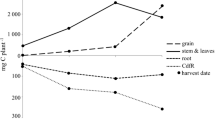Abstract
To determine the effect of microbial metabolites on the release of root exudates from perennial ryegrass, seedlings were pulse labelled with [14C]-CO2 in the presence of a range of soil micro-organisms. Microbial inoculants were spatially separated from roots by Millipore membranes so that root infection did not occur. Using this technique, only microbial metabolites affected root exudation. The effect of microbial metabolites on carbon assimilation and distribution and root exudation was determined for 15 microbial species. Assimilation of a pulse label varied by over 3.5 fold, dependent on inoculant. Distribution of the label between roots and shoots also varied with inoculant, but the carbon pool that was most sensitive to inoculation was root exudation. In the absence of a microbial inoculant only 1% of assimilated label was exuded. Inoculation of the microcosms always caused an increase in exudation but the percentage exuded varied greatly, within the range of 3–34%.
Similar content being viewed by others
References
Barber D A and Gunn K B 1974 The effect of mechanical forces on the exudation of organic substances by roots of cereal plants grown under sterile conditions. New Phytol. 73, 39–45.
Beck M and Gilmore C M 1983 Role of wheat root exudates in associative nitrogen fixation. Soil Biol. Biochem. 15, 33–38.
Biondini M, Klein D A and Redente E F 1988 Carbon and nitrogen losses through root exudation by Agropyron cristatum, A. Smithii and Bouteloua gracilis. Soil Biol. Biochem. 20, 477–482.
Booth C 1971 The genus Fusarium. Commonwealth Agricultural Bureaux, London.
Bowen G D 1980 Misconceptions, concepts and approaches in rhizosphere biology. In Contemporary Microbial Ecology. Eds. D CEllwood, J NHedger, M JLatham, J MLynch and J HSlater. pp 283–304. Academic Press, London.
Bowen G D and Rovira A D 1992 The rhizosphere: the hidden half of the hidden half. In Plant Roots: The Hidden Half. Eds. YWaisel, AEshel and UKafkafi. pp 641–669. Marcel Decker, New York.
Gillespie-Sasse L M J, Almassi F, Ghisalberti E L and Sivasithamparam K 1991 Use of a clean seedling assay to test plant growth promotion by exudates from a sterile red fungus. Soil Biol. Biochem. 23, 95–97.
Laheurte F and Berthelin J 1988 Effect of phosphate solubilizing bacteria on maize growth and root exudation over four levels of labile phosphorus. Plant and Soil 105, 11–17.
Lee K J and Gaskins M H 1982 Increased root exudation of 14C-compounds by sorghum seedlings inoculated with nitrogen-fixing bacteria. Plant and Soil 69, 391–399.
Lynch J M 1983 Soil Biotechnology. Blackwell Scientific Publications, Oxford.
Lynch J M and Whipps J M 1990 Substrate flow in the rhizosphere. Plant and Soil 129, 1–10.
Meharg A A and Killham K 1991 A novel method of determining root exudates in the presence of soil micro-flora. Plant and Soil 133, 111–116.
Minchin P E H and MacNaughton G S 1984 Exudation of recently fixed carbon by non-sterile roots. J. Exp. Bot. 35, 74–82.
Papavizas G C 1985 Trichoderma and Gliocladium. Biology, ecology and potential for biocontrol. Ann. Rev. Phytopathol. 23, 23–54.
Prikryl Z and Vancura V 1980 Root exudates of plants. VI. Wheat root exudation as dependent on growth. Concentration gradient of exudates in the presence of bacteria. Plant and Soil 57, 69–83.
Raper K B and Thom C 1949 A Manual of the Penicillia. Hafner, New York.
Rovira A D, Newman E I, Bowen H J and Campbell R 1974 Quantitative assessment of rhizoplane microflora by direct microscopy. Soil Biol. Biochem. 6, 211–216.
Snellgrove R C, Splittstoesser W E, Stribley D P and Tinker P B 1982 The distribution of carbon and the demand of the fungal symbiont in leek plants with vesicular-arbuscular mycorrhizae. New Phytol. 92, 75–87.
Thom C and Raper K B 1945 A Manual of the Aspergilli. The Williams and Wilkins Company, Baltimore.
VanVuurde J W L and Schippers B 1980 Bacterial colonization of seminal wheat roots. Soil Biol. Biochem. 12, 559–565.
Author information
Authors and Affiliations
Rights and permissions
About this article
Cite this article
Meharg, A.A., Killham, K. Loss of exudates from the roots of perennial ryegrass inoculated with a range of micro-organisms. Plant Soil 170, 345–349 (1995). https://doi.org/10.1007/BF00010488
Received:
Accepted:
Issue Date:
DOI: https://doi.org/10.1007/BF00010488




